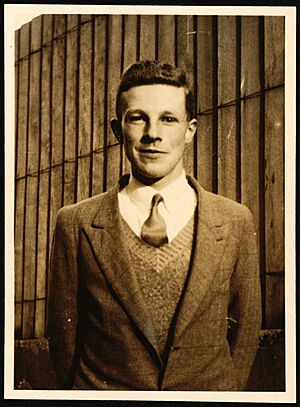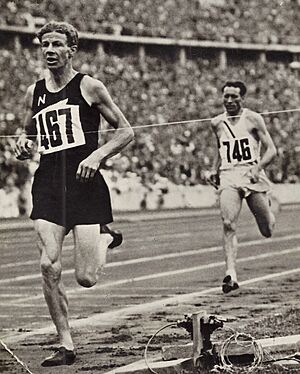Jack Lovelock facts for kids

Lovelock at the 1936 Olympics
|
||||||||||||||||||||
| Personal information | ||||||||||||||||||||
|---|---|---|---|---|---|---|---|---|---|---|---|---|---|---|---|---|---|---|---|---|
| Nationality | New Zealand | |||||||||||||||||||
| Born | 5 January 1910 Crushington, New Zealand |
|||||||||||||||||||
| Died | 28 December 1949 (aged 39) Brooklyn, New York, U.S. |
|||||||||||||||||||
| Height | 169 cm | |||||||||||||||||||
| Weight | 61 kg | |||||||||||||||||||
| Sport | ||||||||||||||||||||
| Sport | Running | |||||||||||||||||||
| Event(s) | 1500 m, mile | |||||||||||||||||||
| Club | University of Oxford Achilles Club |
|||||||||||||||||||
| Achievements and titles | ||||||||||||||||||||
| Personal best(s) | 1500 m – 3:47.8 (1936) Mile – 4:07.6 (1933) |
|||||||||||||||||||
|
Medal record
|
||||||||||||||||||||
John Edward Lovelock (born January 5, 1910 – died December 28, 1949) was an amazing athlete from New Zealand. He was a world record holder in running the 1500 meters and the mile. He also won a gold medal at the 1936 Summer Olympics in the 1500 meters race.
Contents
Early Life and School Days
Jack Lovelock was born in a small town called Crushington, near Reefton, in New Zealand. His parents had moved there from England.
From a young age, Jack was good at many things, not just sports. At Fairlie School, he was the best student in his class. He also played rugby, swam, and ran track. He was even a prefect, which means he helped lead other students.
When he went to Timaru Boys' High School, he kept setting new records in athletics. But he was also involved in almost everything else at school. In his last year, 1928, he was the top student, head prefect, and even won the school's boxing championship!
After high school, he went to the University of Otago to study medicine. He continued to show his talent in sports there. In 1931, he won a special scholarship called a Rhodes Scholarship. This allowed him to study at Oxford University in England. He later became a medical doctor.
An Amazing Sports Career
In 1932, Jack Lovelock was already a famous runner. He held the British Empire record for the mile race. That year, he competed in the 1932 Summer Olympics in Los Angeles. He finished 7th in the 1500 meters race.
The next year, he set a new world record for the mile, running it in 4 minutes and 7.6 seconds. This happened during a race against another great runner, Bill Bonthron.
In 1934, Jack won a gold medal at the 1934 British Empire Games in London. He won the mile race with a time of 4 minutes and 13 seconds. He knew he could only give his absolute best effort once a season.
Winning Gold at the Berlin Olympics
The most exciting part of Jack's career was in 1936. He won the gold medal in the 1500 meters race at the 1936 Summer Olympics in Berlin. He also set a new world record in the final race, finishing in 3 minutes and 47.8 seconds.
Jack had planned his race strategy very carefully since his loss in Los Angeles. He used a new and surprising tactic. This race is still remembered as one of the best 1500-meter Olympic finals ever. Many top runners from that time were competing.
Some of his rivals included Glenn Cunningham, who had broken Jack's world mile record in 1934. Other strong runners were Luigi Beccali and Sydney Wooderson. In the final race, Jack surprised everyone. He made a sudden sprint with 300 meters left to go. This caught his opponents off guard.
Jack Lovelock was the captain of the New Zealand Olympic team that year. After the Berlin Olympics, he raced one more time for the British Commonwealth team. His last race was in Princeton, where he was beaten by Archie San Romani.
Jack continued to be interested in athletics. He even wrote for newspapers until World War II began.
Later Life and Legacy
During World War II, Jack Lovelock served as a major in the Royal Army Medical Corps. He married Cynthia James in 1945, and they had two daughters.
In 1946, he started working at Manhattan Hospital in New York City. On December 28, 1949, he called his wife to say he was coming home early because he wasn't feeling well. He was waiting at a subway station in Brooklyn, New York. He fell onto the tracks and was hit by a train. It is thought he might have had a dizzy spell. He had suffered from these spells after falling from a horse in 1940.
Remembering Jack Lovelock
Jack Lovelock is still remembered as a hero in New Zealand. In 1990, the New Zealand post office released stamps featuring him.
The New Zealand Ministry for Culture and Heritage says that Jack Lovelock "captured the imagination" of people. Streets, sports fields, and even sports bars are named after him. His story has inspired books, plays, and a film.
In 2002, a statue of him was put up at Timaru Boys' High School. This is where many of his important belongings and memories are kept. The "Victory Oak" tree he received from the 1936 Olympics was planted at the school. It is now a protected landmark.
There is also an annual athletics event called the Lovelock Classic held in Timaru. The main race at this event is the men's mile run. A street in Hamilton, New Zealand, called Lovelock Place, is also named in his honor.
Images for kids
-
Lovelock Oak (Olympic oak tree from Berlin, 1936)








